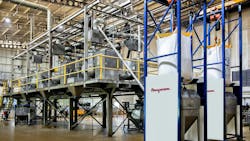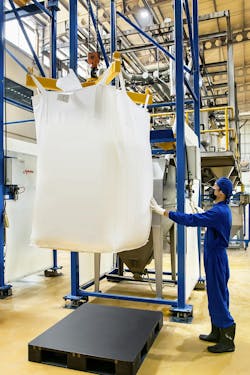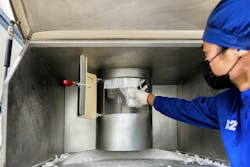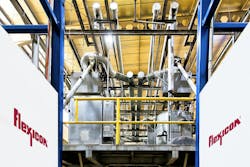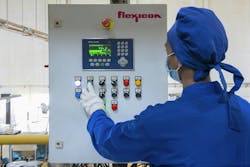Bulk bag weigh batch discharging system doubles production capacity, cuts labor costs
Key Takeaways:
- Production Efficiency: Singabera doubled its production capacity while cutting labor requirements by 70% through the installation of Flexicon’s bulk bag weigh batch discharging and conveying systems.
- Quality & Safety: The automated system ensures consistency, reduces contamination risks, and improves workplace safety by eliminating heavy manual labor and minimizing dust.
- Scalability & Flexibility: The system accommodates both 1-tonne bulk bags and 25-kg bags, allowing the company to adapt to supply variations while streamlining storage and distribution efficiency.
Singabera — headquartered in Sukoharjo, in the Central Java province of Indonesia — produces natural ginger drink mixes and other Indonesian specialties from locally sourced ingredients and ships them to buyers in Australia, Singapore, Hong Kong, China, Japan, and North America.
"We are committed to creating the highest quality products derived from natural plants while managing our environmental footprint," says managing director Michael Na.
"At the old factory, we added coconut and cane sugar from 25-kg (55-lb) bags, and everything was done by hand, including transporting and weighing the sugar and cutting the bags open one by one," says Na. "That was a lot of work."
Foreign objects entering the process was another concern. "The U.S. is our biggest market, and the standards are very strict. Any concern about quality is unacceptable," Na says. "We needed to do something different to have fewer people at the operation and to ensure consistency."
To meet growing demand and raise quality standards, Singabera built a new factory and installed twin BULK-OUT bulk bag weigh batch dischargers, each feeding parallel lines of three flexible screw conveyors, from Flexicon (Singapore) Pte.
The automated system weighs and delivers fine sugar to six juice cookers at high rates while containing dust and improving safety.
Automated weigh batch system handles bulk bags and handheld bags
The twin bulk bag discharging and conveying lines are positioned side-by-side and parallel to one another, each supplying sugar to three cookers on a 2-m (6.5-ft) high mezzanine.
Each model BFC discharger is mounted on load cells and equipped with a cantilevered I-beam, hoist and trolley that lifts and positions a 1-tonne (2,200-lb) bulk bag into the discharger frame without the need for a forklift. A worker pulls the outlet spout through a 380-mm (15-in.) diameter iris valve, which closes around the spout, preventing material flow. The spout is then untied and the valve opened slowly, preventing uncontrolled bursts of material and dust from entering the 400-L (14-cu-ft) floor hopper.
To promote evacuation of sugar from bulk bags, FLOW-FLEXER bag activators raise and lower opposite bottom edges of the bag with increasingly longer strokes as the bag lightens, eventually raising the bag bottom into a steep 'V" shape.
The hoppers include a bag dump hood for manually adding sugar from 25-kg (55-lb) bags, providing Singabera the flexibility to use material from bags of multiple sizes. "Most factories in Indonesia still use the smaller bags," Na explains, "and sometimes we have to use them because of supply shortages."
Discharging smaller bags at floor level into the manual bag dumping station means that workers no longer need to carry the bags up ladders or stairs to empty the contents into the cooker. This not only reduces the risk of injury from a repetitive and potentially hazardous manual process, it also reduces the time to achieve the desired batch weights when using smaller bags. A rigid screen keeps foreign objects and packaging material out of the hopper and supports the bag to ease the strain on workers.
Flexible screw conveyors feed multiple juice cookers selectively by weight
The floor hopper for each station charges an inclined 7.5-m (24.6-ft) long flexible screw conveyor that either feeds the first juice cooker or the charging adapter of a horizontally oriented 4.5-m (15-ft) flexible screw conveyor. The horizontal conveyor can, in turn, feed the second juice cooker or the charging adapter of another horizontally oriented 4.5-m (15-ft) long flexible screw conveyor that feeds the third juice cooker.
The sugar discharging from the inclined conveyor passes through a short length of downspout into a pneumatically actuated slide gate valve, which either opens to deposit the sugar into the cooker or closes to move the sugar through the horizontal conveyor to the next discharge point. The closed slide gate also reduces the effects of the cooker's heat and steam on the sugar which could otherwise agglomerate and cause the conveying line to shut down.
Each conveyor's stainless steel outer tube encloses a flexible steel spiral that is driven beyond the point of discharge, preventing material contact with the bearings or seals.
Once an operator selects which juice cooker should receive a batch of sugar, a PLC actuates the corresponding slide gate valve(s) and 4-kW (5.4-hp) gear drive(s) of one, two or three of the horizontal conveyors.
When feeding the first juice cooker, the PLC runs the inclined conveyer first at full rate and then at trickle feed rate prior to stopping the conveyor when the bulk bag discharger has lost the accurate batch weight. When feeding the second or third juice cooker, the PLC additionally starts and stops the horizontally oriented conveyor(s) in the same manner.
Once a batch of sugar — typically 150 kg (332 lb) — is added to a corresponding volume of juice, the solution cooks for 45 to 60 minutes.
PLC-controlled batching system increases capacity, accuracy and consistency
A level switch in each bulk bag discharger's floor hopper signals when workers need to load another bulk bag. The PLC maintains in-process batch information to ensure that weight accuracy is maintained during changeovers.
Depending on the season, Singabera runs its drink-making process over two or three 8-hour shifts, employing three workers per shift instead of 10 workers required previously. Sugar throughput is 7 to 15 tonnes (15.4 to 33 tons) a day, twice what the old factory could handle.
"The system eliminates heavy manual labor, helping worker well-being tremendously," Na says. "Other benefits are accuracy, consistency, and hygiene." The bulk bags also improve storage. "We can stack them using forklifts or put them on racks, making warehousing more efficient than with smaller bags. Flexicon gave us a turnkey solution, and it's been working to its full capabilities.
About the Author
Jhuning Chng
Jhuning Chng is the general manager of Flexicon Singapore and has been with the company since 2013. He holds a Master’s degree in Business Administration from the University of Manchester and brings extensive experience in bulk material handling solutions across the food, chemical, mineral, and packaging processing industries.
